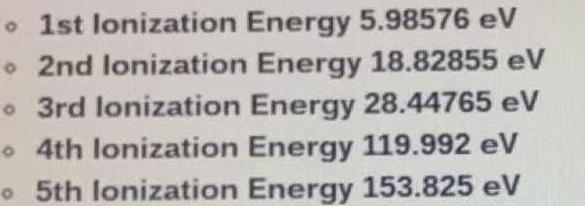The following energies were found for an unknown element ionization. What is a common ion for the unknown element above?

1 Answer
The expected charge is +3 (although +1 may exist as well).
Explanation:
This element is a member of the column headed by boron. It has three valence electrons.
Here's how we know:
Suppose all of the first three ionization energies involved removal of valence electrons. If these electrons originate in the same subshell (2
To explain, you need to consider what is left behind as each electron is removed. In the case of the first electron, we are removing it from an ion of +1 charge (the nucleus and the remaiinng electrons). The electric force on the electron is related to the charge on the remaining ion.
The second electron is removed from an ion of charge +2, and the third electron from a charge of +3. As the charge on the rest of the atom increases, so does the force on our electron, and the energy needed to remove it.
When we look at the element given, we find that
It tells us that the 1st electron is being removed from a subshell such as
The energy to remove the fourth electron is vastly greater, suggesting it is not a valence electron at all.
So, our element has three valence electrons, and would be expected to form an ion of +3 charge (as three electrons are readily removed).

